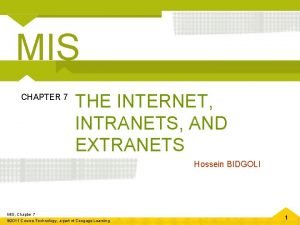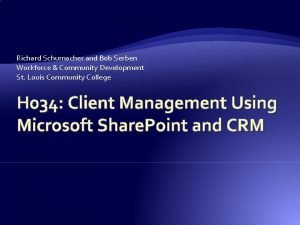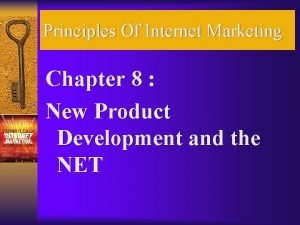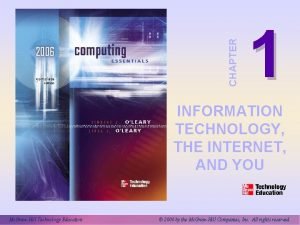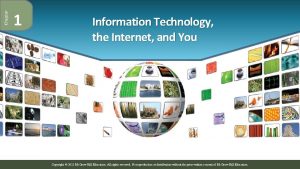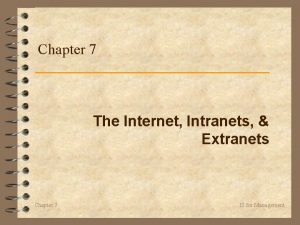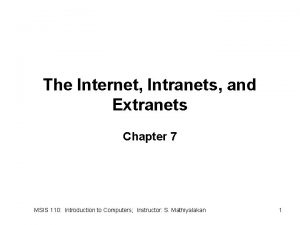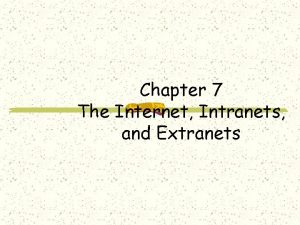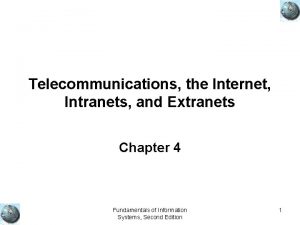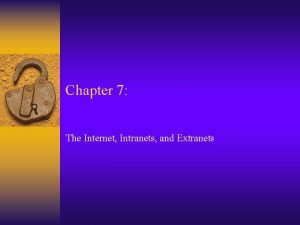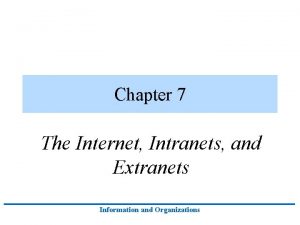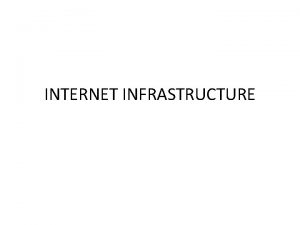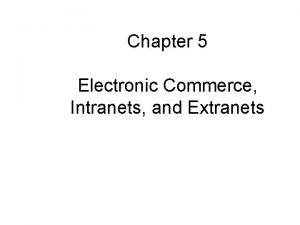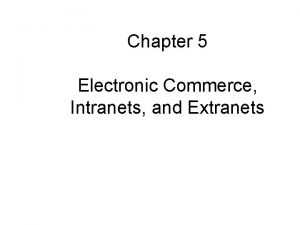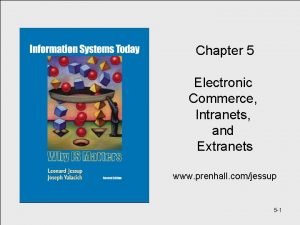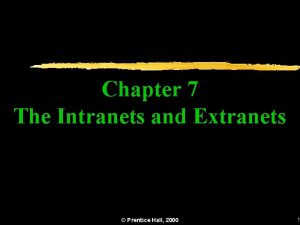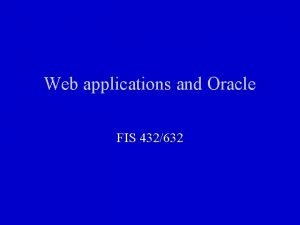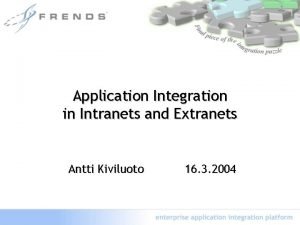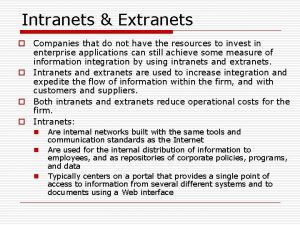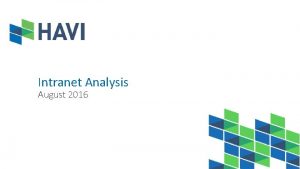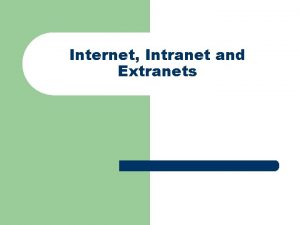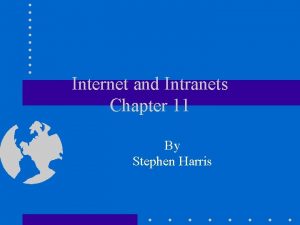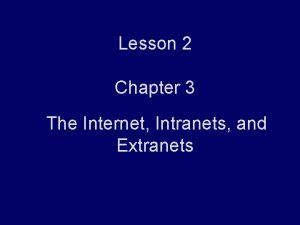The Internet Intranets and Extranets Chapter 7 Principles
















































- Slides: 48

The Internet, Intranets, and Extranets Chapter 7 Principles of Information Systems, Sixth Edition 1

Chapter 7 Outline • • • Use and Function of the Internet servces The Worldwide Web Intranets and Extranets Net Issues Principles of Information Systems, Sixth Edition 2

Use and Functioning of the Internet Principles of Information Systems, Sixth Edition 3

Use and Functioning of the Internet • • ARPANET Internet Protocol (IP) Wireless Internet Research for a faster Internet – Internet 2 (I 2) – Next Generation Internet (NGI) – Corporate efforts Principles of Information Systems, Sixth Edition 4

Routing Messages Over the Internet Principles of Information Systems, Sixth Edition 5

U. S. Internet Usage Principles of Information Systems, Sixth Edition 6

How the Internet Works • Hosts • Routers forward packets to other networks • Internet Protocol Stack (TCP/IP) – Internet Protocol (IP) – Transport Control Protocol (TCP) • Backbones Principles of Information Systems, Sixth Edition 7

Uniform Resource Locator (URL) • http: //www. course. com/index. html Hypertext transfer protocol Domain name (Default) File Name Note: 1. The fourth component is the “Path” which is not shown here. 2. http: // is the default protocol Principles of Information Systems, Sixth Edition 8

U. S. Top Level Domain Affiliations Principles of Information Systems, Sixth Edition 9

Accessing the Internet • Connection via a LAN server – Network adapter card – Open Datalink Interface (ODI) – Network Driver Interface Specification (NDIS) Principles of Information Systems, Sixth Edition 10

Accessing the Internet Principles of Information Systems, Sixth Edition 11

Internet Service Providers (ISPs) • Provide Internet access to account holders • Monthly fee varies • Some are free Principles of Information Systems, Sixth Edition 12

Internet Service Providers (ISPs) Principles of Information Systems, Sixth Edition 13

Internet Services Principles of Information Systems, Sixth Edition 14

Internet Services Principles of Information Systems, Sixth Edition 15

Internet Services Principles of Information Systems, Sixth Edition 16

E-mail and Instant Messaging Principles of Information Systems, Sixth Edition 17

ICQ Principles of Information Systems, Sixth Edition 18

Usenet Newsgroups Principles of Information Systems, Sixth Edition 19

Internet Phone and Videoconferencing Services Principles of Information Systems, Sixth Edition 20

Other Internet Services Principles of Information Systems, Sixth Edition 21

The World Wide Web Principles of Information Systems, Sixth Edition 22

The World Wide Web • Menu-based system that uses client/server model • Hypermedia • HTML, XML • Web browsers • Java • Search engines – Keyword indexes: fast & broad – Subject indexes: focused searches Principles of Information Systems, Sixth Edition 23

Some Interesting Web Sites Principles of Information Systems, Sixth Edition 24

Hypertext Markup Language Principles of Information Systems, Sixth Edition 25

Google Principles of Information Systems, Sixth Edition 26

Popular Search Engines Principles of Information Systems, Sixth Edition 27

Java Principles of Information Systems, Sixth Edition 28

Java Principles of Information Systems, Sixth Edition 29

CVS. com Principles of Information Systems, Sixth Edition 30

Intranets and Extranets Principles of Information Systems, Sixth Edition 31

Intranet • Internal corporate network built using Internet and World Wide Web standards and products • Slashes the need for paper • Provides employees with an easy and intuitive approach to access information that was previously difficult to obtain • Only accessible inside an organization. Principles of Information Systems, Sixth Edition 32

Intranet Principles of Information Systems, Sixth Edition 33

Extranet • A network that links selected resources of the intranet of a company with its customers, suppliers, or other business partners. • Access is often controlled by using a password and VPN (see slide 36). Principles of Information Systems, Sixth Edition 34

Internet, Intranet, and Extranet Users Principles of Information Systems, Sixth Edition 35

Virtual Private Network Principles of Information Systems, Sixth Edition 36

Developing Web Content • • • Computer must be linked to a Web server Need Web browser program Add links to home page Advertise Tools – – Word processors HTML editor HTML template Text editor Principles of Information Systems, Sixth Edition 37

Push Technology • Used to send information automatically over the Internet • Relies on HTTP or Java technology • Drawbacks include: – Information overload – Volume of data broadcast Principles of Information Systems, Sixth Edition 38

Business Uses of the Web • E-mail • Linking buyers and sellers • Tool for marketing, sales, and customer support • Low-cost alternative to fax or express mail Principles of Information Systems, Sixth Edition 39

Net Issues • Management issues • Service and speed issues – Routers can become bottlenecks – Connection agreements • Privacy – Cookie: text file placed on the hard disk of a computer system • Fraud • Security with encryption and firewalls – Digital signatures, Cyphertext, Cryptography • Unauthorized sites Principles of Information Systems, Sixth Edition 40

Cryptography Principles of Information Systems, Sixth Edition 41

Fed. CIRC Principles of Information Systems, Sixth Edition 42

The Web in Three Dimensions Principles of Information Systems, Sixth Edition 43

Summary • Internet - started with ARPANET, a project started by the U. S. Department of Defense (DOD) • Internet services include: – E-mail – Telnet – FTP – Usenet and newsgroups – Chat rooms • Web site - like a magazine, with a cover page called a home page that has graphics, titles, black and highlighted text Principles of Information Systems, Sixth Edition 44

Principles and Learning Objectives • The Internet is like many other technologies – it provides a wide range of services, some of which are effective and practical for use today, others are still evolving, and still others will fade away from lack of use. – BRIEFLY DESCRIBE HOW THE INTERNET WORKS, DIFFERENT WAYS TO CONNECT TO IT AND THE ROLE OF INTERNET SERVICE PROVIDERS. – IDENTIFY & DESCRIBE THE SERVICES ASSOCIATED W/ THE INTERNET. Principles of Information Systems, Sixth Edition 45

Principles and Learning Objectives • Originally developed as a documentmanagement system, the World Wide Web is a menu-based system that is easy to use for personal and business applications. – DESCRIBE THE WORLD WIDE WEB AND HOW IT WORKS INCLUDING THE USE OF WEB BROWSERS, SEARCH ENGINES, AND OTHER WEB TOOLS. Principles of Information Systems, Sixth Edition 46

Principles and Learning Objectives • Before the Internet and the World Wide Web become universally used and accepted for business use, management issues; service and speed issues; and fraud, security and unauthorized Internet sites must be addressed and solved. – IDENTIFY WHO IS USING THE WEB TO CONDUCT BUSINESS AND DISCUSS SOME OF THE PROS AND CONS OF WEB SHOPPING. – OUTLINE THE PROCESS FOR CREATING WEB CONTENT. – DESCRIBE JAVA. DISCUSS ITS POTENTIAL IMPACT ON THE SOFTWARE WORLD. – DEFINE THE TERMS INTRANET AND EXTRANET AND DISCUSS HOW ORGANIZATIONS ARE USING THEM. – IDENTIFY SEVERAL ISSUES ASSOCIATED WITH THE USE OF NETWORKS. Principles of Information Systems, Sixth Edition 47

End of Chapter 7 Principles of Information Systems, Sixth Edition 48
 Mis chapter 7
Mis chapter 7 Sps intranets
Sps intranets Internet or internet
Internet or internet Hát kết hợp bộ gõ cơ thể
Hát kết hợp bộ gõ cơ thể Lp html
Lp html Bổ thể
Bổ thể Tỉ lệ cơ thể trẻ em
Tỉ lệ cơ thể trẻ em Chó sói
Chó sói Tư thế worm breton
Tư thế worm breton Hát lên người ơi alleluia
Hát lên người ơi alleluia Môn thể thao bắt đầu bằng chữ đua
Môn thể thao bắt đầu bằng chữ đua Thế nào là hệ số cao nhất
Thế nào là hệ số cao nhất Các châu lục và đại dương trên thế giới
Các châu lục và đại dương trên thế giới Công thức tính thế năng
Công thức tính thế năng Trời xanh đây là của chúng ta thể thơ
Trời xanh đây là của chúng ta thể thơ Cách giải mật thư tọa độ
Cách giải mật thư tọa độ Làm thế nào để 102-1=99
Làm thế nào để 102-1=99 độ dài liên kết
độ dài liên kết Các châu lục và đại dương trên thế giới
Các châu lục và đại dương trên thế giới Thơ thất ngôn tứ tuyệt đường luật
Thơ thất ngôn tứ tuyệt đường luật Quá trình desamine hóa có thể tạo ra
Quá trình desamine hóa có thể tạo ra Một số thể thơ truyền thống
Một số thể thơ truyền thống Cái miệng nó xinh thế
Cái miệng nó xinh thế Vẽ hình chiếu vuông góc của vật thể sau
Vẽ hình chiếu vuông góc của vật thể sau Thế nào là sự mỏi cơ
Thế nào là sự mỏi cơ đặc điểm cơ thể của người tối cổ
đặc điểm cơ thể của người tối cổ Ví dụ giọng cùng tên
Ví dụ giọng cùng tên Vẽ hình chiếu đứng bằng cạnh của vật thể
Vẽ hình chiếu đứng bằng cạnh của vật thể Vẽ hình chiếu vuông góc của vật thể sau
Vẽ hình chiếu vuông góc của vật thể sau Thẻ vin
Thẻ vin đại từ thay thế
đại từ thay thế điện thế nghỉ
điện thế nghỉ Tư thế ngồi viết
Tư thế ngồi viết Diễn thế sinh thái là
Diễn thế sinh thái là Dạng đột biến một nhiễm là
Dạng đột biến một nhiễm là Số.nguyên tố
Số.nguyên tố Tư thế ngồi viết
Tư thế ngồi viết Lời thề hippocrates
Lời thề hippocrates Thiếu nhi thế giới liên hoan
Thiếu nhi thế giới liên hoan ưu thế lai là gì
ưu thế lai là gì Hươu thường đẻ mỗi lứa mấy con
Hươu thường đẻ mỗi lứa mấy con Khi nào hổ con có thể sống độc lập
Khi nào hổ con có thể sống độc lập Sơ đồ cơ thể người
Sơ đồ cơ thể người Từ ngữ thể hiện lòng nhân hậu
Từ ngữ thể hiện lòng nhân hậu Thế nào là mạng điện lắp đặt kiểu nổi
Thế nào là mạng điện lắp đặt kiểu nổi Principles of marketing chapter 8
Principles of marketing chapter 8 Internet design principles
Internet design principles Chapter 1 information technology the internet and you
Chapter 1 information technology the internet and you Chapter 1 information technology the internet and you
Chapter 1 information technology the internet and you
